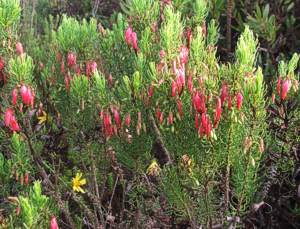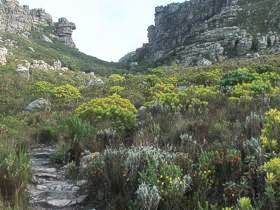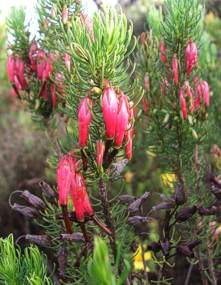Erica plukenetii
Erica plukenetii L.
Family: Ericaceae
Common names: Plukenet's heath (Eng.); hangertjie (Afr.)
Introduction
Erica plukenetii is a common species that is found on mountain slopes throughout most of the Cape Floristic Region.

Description
Description
Erica plukenetii is an erect, sturdy shrub that grows up to 900 mm, but some forms may reach a height of up to 2 m. It has very distinctive, long, thin, needle-like leaves that curve upwards, giving the plants the appearance of small pine trees. It produces dense clusters of hanging tubular flowers, the colour varies from white, pink, red, green to yellow. The corolla is a partially inflated tube, varying from 7 to 18 mm long with anthers that protrude far from the tube. These far-exserted stamens are a particular feature of this species. It flowers at different times of the year depending on the locality. On the Cape Peninsula it flowers mainly during late summer-winter-spring (March to September).
Conservation Status
Status
Erica plukenetii is widespread, occurring in many areas that are protected nature reserves and is, therefore, not regarded as threatened.
Distribution and habitat
Distribution description
Erica plukenetii has a wide distribution range, from the Spektakelberg in Namaqualand eastwards to Mossel Bay and into the dry mountains of the little Karoo. It grows on mountain slopes and flats amongst rocks and in sandy, well-drained soils.
Derivation of name and historical aspects
History
Erica plukenetii was named by Linnaeus in honour of Leonard Plukenet (1641-1706), who was a physician by profession but also a botanist of high repute, gardener to Queen Mary and superintendent of the Hampton Court garden. He published Phytographia in which he described and illustrated more than 2 700 rare exotic plants. He was also the first author to mention a Cape species of erica, in his book Almagesti Mantisssa Botanici published in 1700.
Its Afrikaans common name, hangertjie, means 'the little hanger', and is thought to come from the way the sunbirds and sugarbirds appear to 'hang' from the flowers while feeding on the nectar.
Three formerly separate species have been included in this complex, namely Erica plukenetii, E. lineata and E breviflora. They have been sunk into E. plukenetii and are recognized as subsp. plukenetii, subsp. lineata and subsp. breviflora. In addition, there is subsp. bredensis and subsp. penicellata. These subspecies accommodate the variation that is typical of the genus Erica and probably results from relatively rapid speciation in the Cape Flora.

Ecology
Ecology
This species is mainly found on mountain slopes, but also grows on quartzite soils on lowlands near the sea. It is normally seed producing (re-seeders); however, some also resprout.
The main variation in this species is the length and shape of the corolla and sepals, size and texture of its leaves and in its growth habit. The flowers vary from being long, thin and tubular to short and tubular. The buds tend to be thin with the flowers changing shape and becoming inflated as they mature. This species is often visited by sunbirds, which appear to be the main pollinating agent.
Uses
Use
Erica plukenetii is a hardy, attractive erica that is a good garden subject. It also attracts birds to the garden.
Growing Erica plukenetii
Grow

Erica plukenetii, like many other ericas, is very easy to garden with, provided you give it the right conditions. It needs a sunny position with good air circulation and well-drained (sandy), acidic (pH 5 to 6.5) soils. Like most ericas it grows very well in rockeries or sloping ground, although the plants do not mind growing on level sites as long as they are well-drained. The ideal time to plant ericas in the Cape is in autumn or early winter. The planting hole should be large enough to accommodate the size of the container. Remove the plastic bag or pot carefully and take care to keep the root ball intact. Fill in around the plant, firm the soil down lightly and then water well. Place a thick layer (25-50 mm) of mulch around the plant, mulching keeps the soil surface around the plant cool and suppresses weed growth. Do not add manure or strong fertilizer.
When growing ericas in pots it is important to plant them in the correct soil. The growing medium should be well-drained and acidic with no manure and with low levels of phosphate. A well-drained, sandy loam with a pH of between 5 and 6.5, containing 50% humus is recommended.
Erica plukenetii can be propagated by seed or cuttings. Seed should be sown in autumn and treatment with smoke will improve germination, resulting in a higher number of seedlings. Ericas are rooted using semi-hardwood tip or heel cuttings in late summer to autumn or in spring. Treat them with a rooting hormone for semi- hardwood cuttings and place in a well-aerated medium under mist on heated benches.
References
- Baker, H.A. & Oliver, E.G.H. 1967. Ericas in southern Africa. Purnell, Cape Town.
- Brown, N. & Duncan, G. 2006. Grow fynbos plants. Kirstenbosch Gardening Series. South African National Biodiversity Institute, Cape Town.
- Goldblatt, P. & Manning, J. 2000. Cape plants. A conspectus of the Cape flora of South Africa. Strelitzia 9. National Botanical Institute, Pretoria & Missouri Botanical Garden Press, Missouri.
- Schumann, D., Kirsten, G. & Oliver, E.G.H. 1992. Ericas of South Africa. Fernwood Press, Cape Town.
- Smith, C.A. 1966. Common names of South African plants. Memoirs of the Botanical Survey of South Africa No. 35.
- Trinder-Smith, T. 2006. Wild flowers of the Table Mountain National Park. South African Wild Flower Guide 12. Botanical Society of South Africa, Cape Town.
- Van Rooyen, G. & Steyn, H. 1999. Cederberg. South African Wild Flower Guide 10. Botanical Society of South Africa, Cape Town.
Credits
Anthony Hitchcock & Sindile Mzondi
Kirstenbosch National Botanical Garden
December 2008
Plant Attributes:
Plant Type: Shrub
SA Distribution: Western Cape
Soil type: Sandy
Flowering season: Sporadic/All year
PH: Acid
Flower colour: Green, Red, White, Pink, Yellow
Aspect: Full Sun
Gardening skill: Easy
Special Features:
Horticultural zones







Rate this article
Article well written and informative
Rate this plant
Is this an interesting plant?
Login to add your Comment
Back to topNot registered yet? Click here to register.